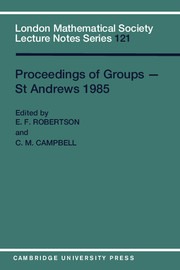Book contents
- Frontmatter
- Contents
- Introduction
- Photograph
- 1 Automorphisms of solvable groups, Part I
- 2 Automorphisms of solvable groups, Part II
- 3 A survey of groups with a single defining relation
- 4 Some algorithms for computing with finite permutation groups
- 5 Five lectures on group rings
- 6 Buildings and group amalgamations
- 7 Finite presentability of S-arithmetic groups
- 8 Efficient presentations of GL(2, ℤ) and PGL(2, ℤ)
- 9 The commutator map
- 10 Polynomial functions and representations
- 11 On questions of Brauer and Feit
- 12 The Picard group and the modular group
- 13 Factor groups of the lower central series of free products of finitely generated abelian groups
- 14 Lattice ordered groups - a very biased survey
- 15 Totally orthogonal finite groups
- 16 One-relator products of groups
- 17 The Cavicchioli groups are pairwise non-isomorphic
- 18 Congruence and non-congruence subgroups of the modular group: a survey
- 19 Small cancellation theory with non-homogeneous geometrical conditions and application to certain Artin groups
- 20 The Lie algebra associated to the lower central series of a group
- 21 Algebraically closed locally finite groups
- 22 On power-commutative and commutation transitive groups
- 23 Dimension function for discrete groups
- 24 Coset graphs
- 25 Nilpotent quotient algorithms
- 26 Generators of p-groups
- 27 On the matrix groups associated to the isometries of the hyperbolic plane
- 28 A characteristic subgroup of N-stable groups
- 29 The isomorphism problem for integral group rings of finite nilpotent groups
- 30 Embedding the root group geometry of 2F4(q)
- 31 On generalized Frobenius complements
- 32 Subgroups of finite index in soluble groups: I
- 33 Subgroups of finite index in soluble groups: II
- 34 Some interconnections between group theory and logic
- 35 Groups covered by abelian subgroups
- 36 Embeddings of infinite permutation groups
- 37 Maximal subgroups of sporadic groups
6 - Buildings and group amalgamations
Published online by Cambridge University Press: 05 March 2012
- Frontmatter
- Contents
- Introduction
- Photograph
- 1 Automorphisms of solvable groups, Part I
- 2 Automorphisms of solvable groups, Part II
- 3 A survey of groups with a single defining relation
- 4 Some algorithms for computing with finite permutation groups
- 5 Five lectures on group rings
- 6 Buildings and group amalgamations
- 7 Finite presentability of S-arithmetic groups
- 8 Efficient presentations of GL(2, ℤ) and PGL(2, ℤ)
- 9 The commutator map
- 10 Polynomial functions and representations
- 11 On questions of Brauer and Feit
- 12 The Picard group and the modular group
- 13 Factor groups of the lower central series of free products of finitely generated abelian groups
- 14 Lattice ordered groups - a very biased survey
- 15 Totally orthogonal finite groups
- 16 One-relator products of groups
- 17 The Cavicchioli groups are pairwise non-isomorphic
- 18 Congruence and non-congruence subgroups of the modular group: a survey
- 19 Small cancellation theory with non-homogeneous geometrical conditions and application to certain Artin groups
- 20 The Lie algebra associated to the lower central series of a group
- 21 Algebraically closed locally finite groups
- 22 On power-commutative and commutation transitive groups
- 23 Dimension function for discrete groups
- 24 Coset graphs
- 25 Nilpotent quotient algorithms
- 26 Generators of p-groups
- 27 On the matrix groups associated to the isometries of the hyperbolic plane
- 28 A characteristic subgroup of N-stable groups
- 29 The isomorphism problem for integral group rings of finite nilpotent groups
- 30 Embedding the root group geometry of 2F4(q)
- 31 On generalized Frobenius complements
- 32 Subgroups of finite index in soluble groups: I
- 33 Subgroups of finite index in soluble groups: II
- 34 Some interconnections between group theory and logic
- 35 Groups covered by abelian subgroups
- 36 Embeddings of infinite permutation groups
- 37 Maximal subgroups of sporadic groups
Summary
The following pages are but a brief summary of five lectures held at the conference “Groups -St Andrews 1985”. We recall basic definitions, state the main results and sketch some applications. Further motivation, detailed proofs and more examples will be published elsewhere. Some extra information can already be found in.
DEFINITIONS. PRELIMINARIES
Amalgamated sums
Let be a set of groups and Ф a set of homomorphisms Ф: AФ → BФ, with AФ, BФ ∈. The inductive limit of the system (,Ф), also called the amalgamated sum of relative to Ф, is a group X endowed with a set of homomorphisms ψA: A → x for all A ∈, such that, for all Ф ∈ Ф, AФ = BФ ˚ Ф the system (X, (ψA)) being universal for that property, in the usual sense. This characterizes (X,(ψA)) up to unique isomorphism. One can also view X as the group defined by the following presentation: the set of generators is the disjoint union of the elements of and the relations are those provided by the multiplication tab les of the elements of X plus all relations of the form Ф(a) = a for Ф ∈ Φ and a ∈ AФ.
- Type
- Chapter
- Information
- Proceedings of Groups - St. Andrews 1985 , pp. 110 - 127Publisher: Cambridge University PressPrint publication year: 1987
- 7
- Cited by

